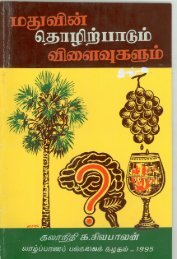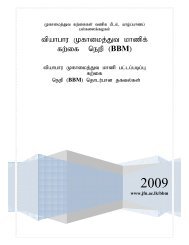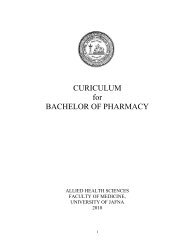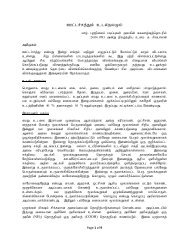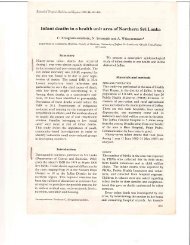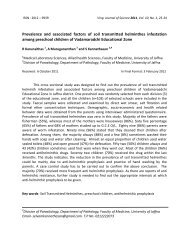MANUAL PHYSIOLOGY PRACTICAL - Repository:The Medical ...
MANUAL PHYSIOLOGY PRACTICAL - Repository:The Medical ...
MANUAL PHYSIOLOGY PRACTICAL - Repository:The Medical ...
Create successful ePaper yourself
Turn your PDF publications into a flip-book with our unique Google optimized e-Paper software.
FM/UOJ<br />
Keep the cells under focus (by constant adjustment of the knob because the<br />
slightest alteration in the depth can affect the image) and move the slide about and study<br />
the structure of various types of cells and their size in relation to red cells. <strong>The</strong> red cells<br />
can be easily identified because they are pink non- nucleated discs found all over the<br />
field. You have to search for the white cells which will be seen as distinct cells with<br />
nucleus stained purple with clear or granulated cytoplasm. Remember that the cells are<br />
spheres and at any time the microscope will be focused only in one plane of the cell.<br />
<strong>The</strong>refore, it will be necessary to adjust the focus up and down to see the cell in full.<br />
Identification of leucocytes<br />
Note the following points with regard to any leucocyte.<br />
a. <strong>The</strong> size and shape of the nucleus.<br />
b. Presence or absence of cytoplasmic granules.<br />
c. When present the size, number and staining reaction of the granules.<br />
If the nucleus occupies only a small portion of the cell and if it is lobulated, the<br />
cell is a polymorpho-nuclear leucocyte. If there are three more clear lobes then the cell<br />
may be Neutrophil; if the lobes are clearly defined and arranged like spectacles then it is<br />
probably an eosinophil; but if the two lobes lie on top of each other because of the<br />
position of the cell, then only one small lobe can be seen. <strong>The</strong> nucleus of the basophil is<br />
enlongated and poorly divided into three lobes.<br />
If the nucleus is not lobulated but spherical and fills almost all the cell then the<br />
cell is a lymphocyte. I the cell has a large kidney shaped nucleus, it is a monocyte; the<br />
nucleus of the monocyte can appear circular or even oval shaped depending on the<br />
orientation of the cell on the slide.<br />
If cytoplasm is clear and light purplish in color, the cell is an agranulocyte. If<br />
there is only scanty cytoplasm then the cell is a lymphocyte can be found is sizes equal to<br />
red cells (small lymphocytes) or much larger than the red cells (large lymphocyte). If<br />
the cells more than double the size of the red cell and lots of clear cytoplasm then the cell<br />
is a monocyte. If the cytoplasm is not clear but no definite granules can be seen and the<br />
nucleus is lobulated, the cell is a neutrophil. If the granules are bluish, large and<br />
discrete, then it is a basophil. If the granules are reddish and just distinguishable as<br />
discrete granules then it is eosinophil. <strong>The</strong> number of granules in an eosinophil is more<br />
than in a basophil.<br />
<strong>The</strong> first and important part of the practical is to observe the different leucocyte<br />
under the microscope and gain experience in identifying them. If you see any cell then<br />
make sure that you identify it correctly by showing it to a teacher. When you come<br />
across a rare cell like monocyte, eosinophil or basophil, show it to others also. If you<br />
could not see one in your slide go around and see these cells in some others microscope.<br />
It is important that you become familiar with the appearance of all leukocytes before<br />
proceeding to the next part of the practical.<br />
Blood<br />
Page | 46



